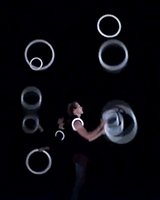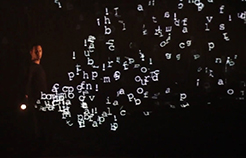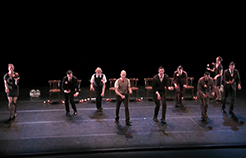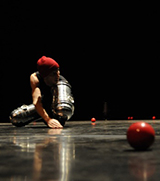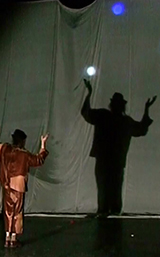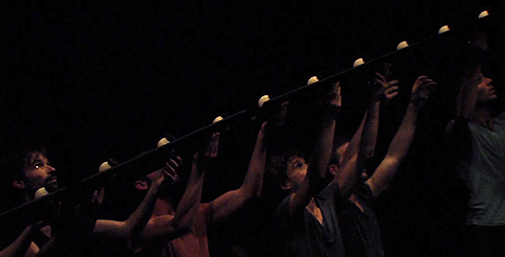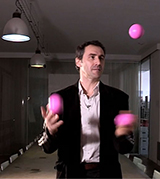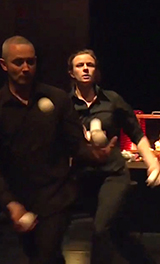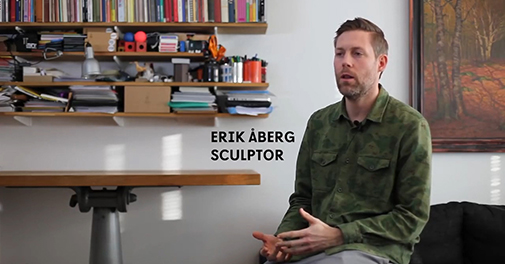by Jean-Michel Guy
Juggling – defined as the periodic manipulation of objects – has undergone several remarkable developments since the 1980s. They concern its very definition, its techniques and its social status.
The first one is even more of a revolution: it is the mathematical equation of possible figures with a given number of objects and a given number of "hands", known as siteswap. This notation system used to record the periodic juggling movement has not only made it possible to write the figures in a universal language based on numbers, understandable by jugglers all over the world, and even to write, as in composing, inventing, complex juggling patterns, as do for example the jugglers Sean Gandini and Denis Paumier. Above all, it has revealed the existence of a calculable and very large number of patterns – several hundred with three balls –, which the jugglers had no idea about until then. The most experienced of them had previously mastered, at best, only about forty patterns, forming a limited vocabulary. The combination of this system with digital technologies has led to virtual creations, such as those of Adrien Mondot and, thanks to the rise of the Internet, to tutorials: it is now possible to learn to juggle in the depths of the jungle, far from any real juggler.
Making it pleasant or impossible for objects to fall
The analysis of juggling was extended by a whole series of deconstructions, which involved questioning properties that had been considered natural or self-evident until then. Thus, the fall of objects, which until then had been seen as a nightmare, was reintegrated as an undeniable and even interesting feature of the juggling process. The current juggler, instead of juggling against gravity, likes to juggle with it, and tends to consider the fall, when it occurs, as a gift, a possible source of inspiration and play. There are various ways of looking at it, even predicting it: A Zen attitude of indifference to the fall, a burlesque interplay, a way of interpreting the unexpected as a rhythmic or melodic surprise, in the same way they do in jazz, as in Jérôme Thomas' Juggling Hands. The most unique way is to make such a thing impossible! By suspending five metal tubes at the same point, juggler Jörg Müller did not merely invent pendulum juggling. He changes the perspective on juggling by substituting the risk of falling, and the shame or sense of fall from grace symbolically attached to it, for the simple possibility of the incident – the tubes can clatter and collide with one another. The combination of juggling with magic and the possibilities of digital technology has also helped to put the essential issue of falling into perspective as never before. Jörg Muller even pushed the experiment of weightlessness juggling by boarding an aircraft in parabolic flight, resulting in a need to redefine it as a system formed by the juggler and the objects surrounding him, who manipulate him as much as he manipulates them.
The increasing variety of juggling styles
Two other remarkable forms of deconstruction are due to two artists of the new circus. The first one is well-known because Bernard Kudlak, who, in Toiles du Cirque Plume, juggles, empty-handed, with the colourful shadows of balls projected on a screen. Beyond its poetry, this image also means that the tangibility of objects is no longer a necessary condition for juggling! As for the very condition of visibility, it has been undermined in a now very large number of juggling acts, following Jérôme Thomas' "zero balls" in Extraballe. Despite the absence of an object, it is not a mime, but an extreme juggling experience that only a juggler can perform.
Another remarkable development is due to technological progress, particularly new materials. The appearance, in the 1980s, of the silicone ball with a high percentage of rebound, made it possible to develop bounce juggling in particular. The industrial moulding of plastic clubs has profoundly contributed to the development of amateur juggling. But at the same time, some jugglers have given up on standard industrial objects to explore juggling with new raw materials: clay, like Nathan Israël or Jimmy Gonzalez, ceramic like Morgan Cosquer.
The tremendous increase in the number of amateur jugglers and the streamlining of juggling training, thanks to siteswap and the multiplication of circus schools, have led to a very significant progress in technical virtuosity. Some now commonly throw a "7 clubs" and there are even juggling competitions, some jugglers going so far as to advocate its recognition as an Olympic sport! This has also led to a diversification of juggling styles and aesthetics: the velocity of a Jay Gilligan, the minimalism of a François Chat, the burlesque of the Defracto company, the strictly vertical – not parabolic – and horizontal throws in the works of the Petit Travers collective (Julien Clément and Nicolas Mathis), extreme juggling with Sébastien Wojdan, quasi-robotic with Clément Dazin, freakishly obsessive with Sylvain Julien who, with his hula-hoops juggling on the ground, updates the flat juggling with hoops from a Bob Bramson of the 1960s…
Juggling is now recognised as an art
Under the influence of Jérôme Thomas in the early 1990s, a new format has emerged: the juggling show lasting at least one hour. Juggler companies multiply and works flourish. Now recognised as an art, juggling even has a public institution in France, La Maison des Jonglages, in La Courneuve, which supports creation in this field and promotes this art, which is now in a state of constant renewal. Once again as a precursor, Jérôme Thomas had identified as a crucial issue, at the beginning of the 2000s, the feminisation of the practice of juggling, which he defended in RainBow, arc après la pluie. The number of female jugglers is increasing, but they are still a very small minority. Another social challenge, which the Maison des Jonglages and in particular the juggler Johann Swartvagher are trying to address, is to spread this practice, which is currently being pursued by the "white middle class", to other social circles which are not familiar with it.
More plastic than ever, juggling is easily combined with all forms of art: dance (as in the creations of Sean Gandini or Stefan Sing, music, with musical balls and other musical instruments juggled by Vincent de Lavenère or the creations of Jörg Müller). But also the theatre, in the juggling of words of the late Rayazone, and the clown with the juggler Nikolaus Holz, magic, with Yann Frisch, Raphaël Navarro or Etienne Saglio. And then there are the plastic arts with Erik Aberg in particular.



